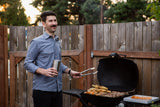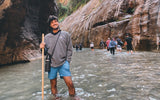Exploring Colorado: A Look Inside Black Canyon of the Gunnison National Park

Words by Sophie Goodman
Known as Colorado’s Grand Canyon, the 30,950 acres that make up Black Canyon of the Gunnison National Park do no less than wow visitors who venture to its edges or into its depths. 2,700-foot sheer-walled cliffs tower over the Gunnison River below – two million years of rushing waters carved out the formidable canyon, exposing metamorphic rock from Earth’s Precambrian era (more than 540 million years ago).
The canyon was brought out of relative obscurity in October of 1999 when it was officially awarded a national park designation. Both indigenous peoples and European explorers had long since avoided the canyon for the challenge that its geography and raging waters posed. Plans for a water diversion tunnel from the Gunnison River began as the Uncompahgre Valley became more populated in the late 19th century. Construction, however, did not begin until 1905 and took four years. The completed four-mile tunnel was dedicated in 1909.
Today, the more than 300,000 visitors per year can hike along the rim and in the canyon, raft and fish the Gunnison River, and enjoy scenic drives along both the North and South Rim of Black Canyon of the Gunnison National Park. I caught up with Black Canyon Park Ranger Nick Myers, a Minnesota native and 19-year Park Service veteran, to learn more about Colorado’s Black Canyon of the Gunnison National Park, his passion for astronomy, and some of his favorite spots in the national park.

Photos courtesy of Nick Myers, Park Ranger at Black Canyon of the Gunnison National Park
Tell me a bit about your background and how you started your career in the National Park Service.
I started in the Park Service in 1999 at a place called Wind Cave National Park in South Dakota. I’ve worked for 13 national parks over the past 19 years, mostly in the West, including Grand Teton and Yellowstone, Zion and Bryce, and Carlsbad Caverns in California. My only eastern Park was the Everglades. I was a seasonal ranger there for about 10 of those years. I’ve been at the Black Canyon for five years now, and this is actually my second stint here, as I worked at the Black Canyon back in 2009 as well. And one of the reasons that I’m here is that I’m an astronomer and the night skies of Western Colorado are perfect for some of the stuff that I’m passionate about, which is astronomy and also bringing astronomy to the people. There are so many people in Colorado, and there’s so much access to public lands and dark places. Here at Black Canyon, we have great dark skies and tons of people live only 15 miles away in Montrose. So, this place is really attractive to me because of the coming together of the natural and human spaces.

Looking upwards at the scaling walls from the floor of the park – Photo by Mudnwaffles via Pixabay
How did you get into astronomy and why do you feel like it’s important to share it with visitors?
I’ve been into it ever since I was a little kid. I’ve always been interested in dark places, which sounds kind of weird, but I’m super interested in caves. They’re not really great for astronomy, but they’re great places to crawl around and explore and learn about extreme life. The above ground version of that is night sky interpretation.
Folks aren’t just coming to national parks for the traditional sightseeing that they might have even 50 years ago. A lot of people are coming here because they’re losing all the opportunity to experience the night sky in their hometowns. Two-thirds of the country can’t see the Milky Way, so they come here for that. And to share that with people and to have them see it for the first time and see how emotional they get… You know, in all the parks I’ve worked at, I’ve seen people more emotional and excited about the night sky than wildlife or history or any of the amazing natural features that national parks were set aside for. It’s really an amazing thing.
It’s also something they can take home with them; if we can teach them some things about astronomy, they might head home and become good advocates for the night sky and work to better light the communities and their homes. It’s a neat way to have people take the national park home with them.

Front row views – Photo courtesy of Dustin Weist via Unsplash
The most famous photo of the Black Canyon of the Gunnison is of its Painted Wall, but outside of that feature and beyond the night sky, what is your favorite feature of the Black Canyon and how do you like to enjoy it?
Tough question for sure, picking a favorite. Visitors are looking for the same kind of answer to that question. The Black Canyon of the Gunnison is a lesser-known park; people come here with a totally clean slate, thinking “what is here?”
A lot of features and activities here are kind of extreme. Rock climbing, kayaking, and even hiking into the canyon. Everything is either straight up or straight down or through a really powerful river, or up some really gnarly rock climbs with old degraded rock. It really challenges the heart and the body. It’s a neat place to push yourself, which can make it hard for first-time visitors who aren’t really prepared for those types of adventures.
80% of the people that come here are going to stick to the rims and have those experiences looking down, and honestly, that’s still one of my favorite things. You drive up to the canyon—and geologically, it’s really unusual because you’re driving up to the top of a canyon—and all of a sudden, it’s just there. There’s no warning, it’s just this wow factor.
It’s so fun to watch people experience it for the first time. Everyone gets out of their cars and they’ll completely ignore each other and just get right to the edge, and they’re just dumbfounded. So, I guess my favorite thing to do is go to the overlooks and watch people have their first experiences with the canyon.

The Painted Wall – Photos courtesy of Jesse Varner (left) and The Dye Clan (right)
How was the Black Canyon formed?
It’s only taken the Gunnison River about 2 million years to carve out this gash. People are kind of blown away because here we can see some of the oldest rock on the planet, but it’s a relatively young canyon. Almost 2 billion-year-old rock and a 2 million-year-old canyon. SO you have this young feature exposing this really old feature. The relative geologic speed of the formation is really amazing.

Photo courtesy of Terry Foote via Wikipedia
And what about human history? Can you tell me a little bit about the indigenous history of the area?
The Ute definitely had a relationship with the canyon, particularly on the rims and the plateaus where you have pinyon and juniper trees along the rims of the canyon. The pinyon nuts were a really important food source for the native peoples, and so you had seasonal migrations to this landscape to harvest the pinyon nuts. You also have some of the oldest pinyon trees in Colorado on the rims of the canyon. There’s evidence all around the park of thousands of years of human habitation and migration, especially upstream of the canyon. There have been some sites found near Blue Mesa Reservoir that approach 10,000 years old. So, we’re talking about a lot of human presence on the land for a very long time.
What’s kind of weird is that when you get off the rim and down into the canyon, you find very little evidence of use or occupation. It doesn’t mean that they didn’t venture there; I’m sure people were going down into the canyon like we do today. There are only a few routes that go down into the canyon from rim to river where you don’t need a rope, but wildlife follow those routes, so if bear and deer were following those routes down to the river, certainly people were following.
One theory out there is that the Gunnison River is so volatile and there’s so little dry ground at the base of the canyon that any evidence was scoured away by generations of floods or was very temporary because the river used to be much more volatile that it is today.

Left: Igneous granite dikes (photo courtesy of James St. John). Right: a Juniper Tree near the rim (photo courtesy of David Fulmer).
The canyon has such a rich history, it’s really amazing.
It’s important to remember that depth of history because we as Americans tend to think of everything in terms of the last 100 years. In the West, 100 years is a long time ago in terms of post-colonial history. The first explorers in the late 1880s thought that the Black Canyon was impenetrable, and then you see the first explorers venturing down into it around 1900. That first run of the river was in 1900, and if you compare that recent history to at least 10,000 years of human habitation in this part of Colorado, the national park as we know it has only been here for the tiniest bit of time.
When was the Black Canyon of the Gunnison National Park established?
We were first established as a national monument. A national monument can be proclaimed by a president without having to get congressional approval, which is outlined in the Antiquities Act of 1906. So, several national monuments were established in the early 1900s leading up to the Great Depression. President Herbert Hoover established the Black Canyon as a national monument in 1933. To be a national park, you have to have a very specific set of criteria. We only have 61 national parks out of the 418 national park service sites in the United States, which includes memorials and battlefields, lakeshores and seashores. But to be a national park, you have to be the most unique of the most unique places that we’ve saved in this country. So, in 1999, Congress decided that the Black Canyon fit the criteria, and we were re-designated as a national park.

Photo courtesy of Alina Aigner via Pixabay
How would you suggest a first-time visitor spend a day in the park?
Touring the South Rim, which is the side closest to Montrose and the most developed side. The North Rim has more of a rural kind of feel with a gravel road and not much in the way of development over there. So, the South Rim is a good place to start. We get almost 70-80% of our visitors every year on the South Rim coming to our visitors center, so we get to contact quite a few people that way. One of the first questions people ask is “what should I do?” We recommend spending time at the ten overlooks along the rim of the canyon. It’s a short walk in between each one, just a few hundred yards, but they take you to many different vantage points and angles and views of the canyon. We have four miles of hiking trails around the visitors center. One trail will take you partially into the canyon and the rest of them all are along the rim.
In two days, you might be able to do a shorter route into the canyon or drive down a very steep road into the canyon to the river, which is a good place to do some fishing. We also have the campground on the South Rim, and we do evening programs in the campground every night. We also do talks and guided walks every day, among other activities. If people want to do more than just a self-guided adventure, we do programs from 9 AM until late at night in the summer months for the astronomy programs.

Photos courtesy of David Smith (left) and Nick Dunlap (right)
Why is Leave No Trace important to you personally? And why is the larger question of public lands conservation important to you as well?
At a park like Black Canyon, which is pretty undeveloped, we don’t have a lot of facilities, so Leave No Trace is about more than just not leaving trash on the ground. We truck in all of our own water, and we have to truck out the sewage and all the trash. We don’t allow fires in the canyon to limit scarring, and we ask people to bring as much of their own stuff as possible. We don’t have a lot of water here, so we encourage people to be self-contained and self-sufficient, especially in winter. We don’t have any water in winter. So, we really focus on the ‘plan ahead and prepare’ aspect of Leave No Trace. Do some research, and don’t come here in flip flops and shorts in March. Make sure you have your winter gear and make sure you brought plenty of food and water for the day. That means that the park will have as little waste as possible, which means you’ll have a much better experience.
Personally speaking, a lot of places that we go to on vacation, we rely on people to take care of us. Whether it’s eating at a restaurant or staying in a hotel, someone else usually does a lot of the work. When people come to parks like the Black Canyon, I encourage them to look at that work as part of the experience. Leave No Trace allows them to have an experience with these places – it’s not just about not leaving your mark, it’s about having some new experiences that you can take back home with you.
Planning a visit to
Colorado’s Black Canyon of the Gunnison National Park? Click here for more information.

Photo courtesy of Patrick Emerson via Flickr





Comments
PAUL Streur said:
MY WIFE AND I VISITED THE BLACK CANYON OF THE GUNNISON THE FALL OF 1999. IT WAS A TRIP TO CELEBRATE MY RETIREMENT WHERE WE PLANNED TO VISIT SEVERAL NATIONAL PARKS, WHICH WE DID. THE BLACK CANYON PARK WAS VERY MUCH UNDER DEVELOPED AT THAT TIME, BUT TOO MUCH DEVELOPEMENT DESROYS THE FEELING OF GRANDUER AT TIMES. WE HAD NO FIRM PLANS WHEN WE LLEFT OUR HOME IN HOLLAND, MICHIGAN WITH THE ONLY RESERVATION A MOTEL IN LUDINGTON MICHIGAN AND RESERVATIONS FOR THE SAILING OF THE SHIP “BADGER” TO WISCONSIN IN THE MORNING. THE TRIP WAS SUCH A GREAT ONE WE NEVER GOT BACK HOME FOR OVER 4 WEEKS AND HAD VISITED MANY GREAT NATIONAL PARKS!
PAUL